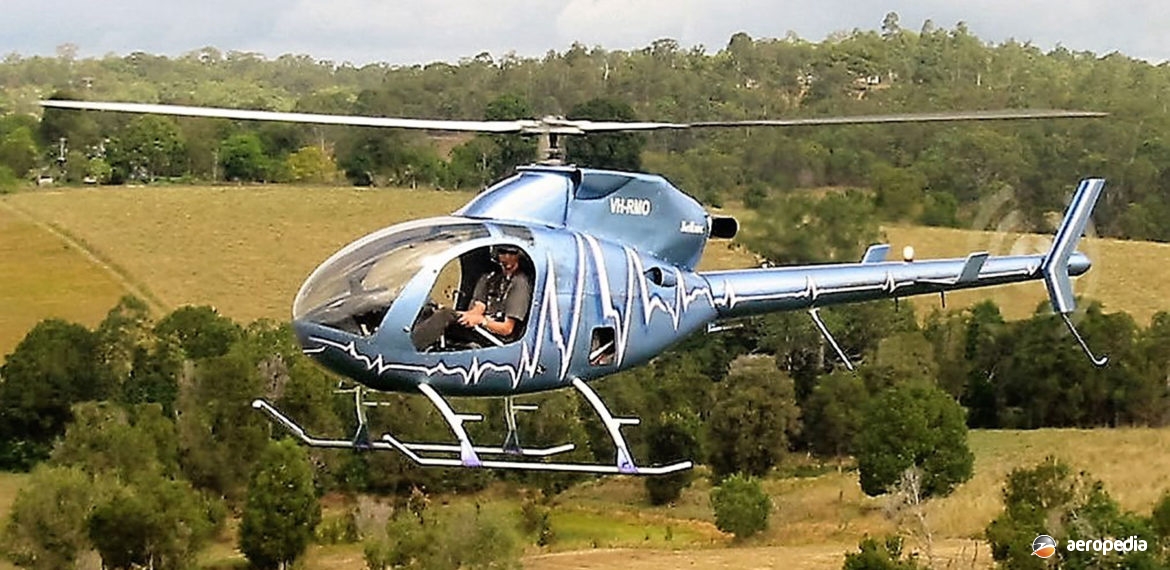Photograph:
JetExec T-62 VH-RMO (c/n RS2301) at Gympie, QLD (Roger Stierli)
Country of origin:
United States of America
Description:
Two-seat light sport helicopter
Power Plant:
One 112 kw (150 shp) Solar T-62-32 turboshaft
Specifications:
- Rotor diameter: 7.62 m (25 ft)
- Length: 6.7 m (22 ft)
- Max speed: 185 km/h (115 mph)
- Rate of climb: 457 m/min (1,500 ft/min)
- Hovering ceiling in ground effect: 2,438 m (8,000 ft)
- Hovering ceiling out of ground effect: 2,743 m (9,000 ft)
- Max range: 378 km (235 miles)
- Fuel capacity: 140 litres (30.8 imp gals)
- Empty weight: 399 kg (880 lb)
- Useful load: 306 kg (675 lb)
- Loaded weight: 700 kg (1,543 lb)
History:
The T-62 is a development by K.I.S.S. Aviation of the kit-built Executive 162 helicopter, which is produced by RotorWay International at Chandler in Arizona, to take a turbine engine, a number of examples being completed in the United States. The machine uses the rotor system, body and airframe from the RotorWay helicopter but the standard petrol engine is replaced by a Solar T-62-32 turboshaft. This unit was originally developed for the US Army for a single-seat helicopter, and a variant is used as an APU in the Boeing Chinook. Usually the high-powered variant is used in the kit and this model is also used in ex-military ground generator units. The turboshaft engine has no warm-up time, has fewer moving parts, is easier to maintain, and causes less wear and tear on the machine and pilot.
The engine provides an additional 15 kw (20 hp) in power over the RotorWay engine and performance is not affected by altitude but it uses 58 litres (12.7 Imp gals) per hour in cruise. JetExec states the engine can use a number of fuels including Jet A, Kerosene, Diesel 1 and 2, and Auto Fuel. An electronic governor maintains 100% rotor RPM. Whereas the RotorWay 162F has belts that drive the main and tail-rotor assemblies, the three belts used to drive the tail-rotor have been replaced with a shaft drive and a tail-rotor gearbox, the main rotor shaft being driven through a large gearbox coupled via a sprag clutch to a reduction gearbox and centrifugal clutch to the engine gearbox. The electrical and fuel systems, and the oil cooling system, were redesigned. Chip detectors are installed in the gearboxes to detect metal particles and give an early warning of problems.
The first of this model to be flown in this region, and in fact in the southern hemisphere, was VH-RMO (c/n RS2301) registered to its owner / builder, Mr Roger Stierli, at Omeau in QLD. The machine was first registered on 10 December 2003 and has a larger fuel tank which has been re-positioned to give an endurance of nearly 2½ hours. A further example was registered to its owner / builder at The Gap, QLD, in March 2007, becoming VH-BXS (c/n 6997), followed by 162 RLF VH-DTU (c/n 6434) registered to its owner at Bloomfield, QLD on 25 January 2016.

